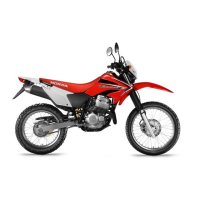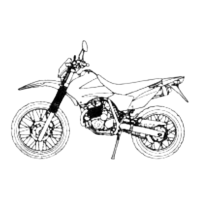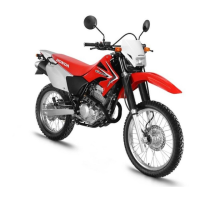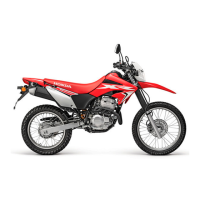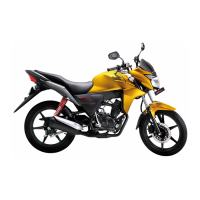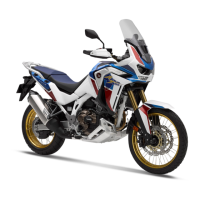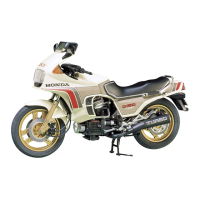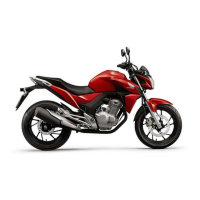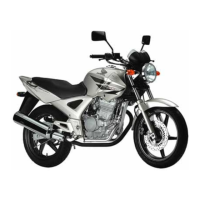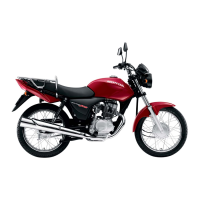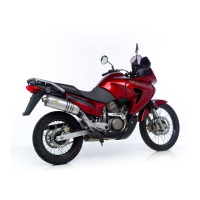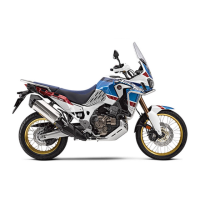Do you have a question about the Honda Today and is the answer not in the manual?
Provides information on the manual's content and emphasizes reading safety, riding, and maintenance tips.
Details the warning symbols used in the manual to alert users to potential dangers.
Emphasizes the necessity of correct protective clothing and helmet for safe riding.
Explains the function of the overspeed warning light installed on the vehicle.
Details legal helmet requirements and the importance of a proper fit for injury reduction.
Recommends performing a daily inspection and keeping the vehicle clean before riding.
Advises stopping the engine and avoiding ignition sources during refuelling.
Warns about carbon monoxide in exhaust fumes and the need for ventilation.
Details how to hold the handlebar and place feet firmly on the ground while riding.
Advises against abrupt steering movements and single-handed riding for control.
Explains how to use the throttle grip to control vehicle speed effectively.
Guides on using both brakes simultaneously and applying them gently.
Details the impact of cargo on handling and specifies load limits for different areas.
Provides precautions for loading items and warns against illegal modifications.
Covers theft prevention, parking surfaces, area selection, and hot component warnings.
Identifies key features like ignition, brakes, storage, and maintenance access points.
Details the speedometer, odometer, and various warning lights on the instrument panel.
Explains the operation of the ignition switch, brake system, and handlebar controls.
Covers steering lock, convenience hook, seat, boot storage, and helmet holder.
Provides step-by-step instructions for locking and unlocking the rear brake.
Details fuel type requirements and critical safety precautions for refuelling.
Outlines steps for starting the engine using the ignition switch or kick starter.
Covers mounting the motorcycle, releasing the brake lock, and throttle control.
Emphasizes checking indicators, mirrors, and surroundings before riding.
Warns about abrupt braking, wet surfaces, and potential brake overheating.
Guides on approaching the stopping position, using indicators, and applying brakes.
Stresses stopping the engine, removing the key, and using a clean, safe maintenance area.
Alerts users to the high temperature of engine, muffler, and exhaust components.
Warns about fatal carbon monoxide in exhaust fumes and avoiding enclosed spaces.
Provides guidelines for safe test riding and emphasizes authorized servicing.
Specifies the initial check required at one month or 1000km for motorcycle longevity.
Highlights the significance of using genuine Honda parts for replacement and service.
Lists key checks for brakes (lever play, performance) and tyres (pressure, damage, wear).
Details engine checks (oil level, starting noise) and lights/indicators inspection.
Illustrates the location of controls like ignition switch, levers, and indicators.
Shows the placement of brake components, tyres, and lights on the motorcycle.
Defines regular service intervals and identifies items requiring technical expertise.
Stresses the importance of consulting an authorized Honda dealer for servicing needs.
Lists inspection points for the engine, lubrication system, clutch, and transmission.
Details inspection items for brake levers, drums, shoes, and tyre condition.
Explains how to measure the free play at the end of the brake levers.
Provides step-by-step instructions for adjusting the free play of the brake levers.
Details how to check the brake shoes for wear using indicator marks.
Emphasizes tyre condition, pressure checks, and visual inspection for damage.
Guides on checking tyre surfaces for cracks, foreign objects, and unusual wear.
Details checking tread depth with wear indicators and selecting appropriate tyres.
Explains the steps for checking the engine oil level using the dipstick.
Lists recommended API, JASO, and SAE specifications for engine oil.
Details how to add engine oil and specifies oil change intervals.
Covers battery type, handling precautions, and terminal cleaning procedures.
Provides first aid measures for contact with battery acid and advice on swallowing.
Details the process for safely removing and reinstalling the motorcycle battery.
Explains how to inspect, remove, and install fuses, stressing correct capacity.
Details how to check transmission oil level and inspect for oil leaks.
Covers air filter type, maintenance intervals, and the procedure for changing the filter.
Advises checking that rubber boots on cables are properly attached.
Provides instructions for cleaning the breather drain at regular intervals.
Details the steps for washing the motorcycle, including precautions for water and pressure.
Offers advice on caring for specific parts like muffler, headlight, paint, and plastic surfaces.
Outlines steps for storing the motorcycle for extended periods, including battery disconnection.
Discusses environmental impact and advises consulting dealers for waste disposal.
Guides on ordering coloured parts and identifying genuine Honda parts.
Explains the importance and location of VIN, engine number, and ignition key code.
Provides guidance on what to check and who to contact in case of a breakdown.
Lists specifications for model type, dimensions, wheelbase, and weight.
Details engine capacity, power, fuel tank capacity, and fuel consumption.
Provides specifications for ignition type, timing, electrical components, and clutch.
Lists specifications for brake lever play, tyre pressure, and engine oil capacity.
Provides information on the manual's content and emphasizes reading safety, riding, and maintenance tips.
Details the warning symbols used in the manual to alert users to potential dangers.
Emphasizes the necessity of correct protective clothing and helmet for safe riding.
Explains the function of the overspeed warning light installed on the vehicle.
Details legal helmet requirements and the importance of a proper fit for injury reduction.
Recommends performing a daily inspection and keeping the vehicle clean before riding.
Advises stopping the engine and avoiding ignition sources during refuelling.
Warns about carbon monoxide in exhaust fumes and the need for ventilation.
Details how to hold the handlebar and place feet firmly on the ground while riding.
Advises against abrupt steering movements and single-handed riding for control.
Explains how to use the throttle grip to control vehicle speed effectively.
Guides on using both brakes simultaneously and applying them gently.
Details the impact of cargo on handling and specifies load limits for different areas.
Provides precautions for loading items and warns against illegal modifications.
Covers theft prevention, parking surfaces, area selection, and hot component warnings.
Identifies key features like ignition, brakes, storage, and maintenance access points.
Details the speedometer, odometer, and various warning lights on the instrument panel.
Explains the operation of the ignition switch, brake system, and handlebar controls.
Covers steering lock, convenience hook, seat, boot storage, and helmet holder.
Provides step-by-step instructions for locking and unlocking the rear brake.
Details fuel type requirements and critical safety precautions for refuelling.
Outlines steps for starting the engine using the ignition switch or kick starter.
Covers mounting the motorcycle, releasing the brake lock, and throttle control.
Emphasizes checking indicators, mirrors, and surroundings before riding.
Warns about abrupt braking, wet surfaces, and potential brake overheating.
Guides on approaching the stopping position, using indicators, and applying brakes.
Stresses stopping the engine, removing the key, and using a clean, safe maintenance area.
Alerts users to the high temperature of engine, muffler, and exhaust components.
Warns about fatal carbon monoxide in exhaust fumes and avoiding enclosed spaces.
Provides guidelines for safe test riding and emphasizes authorized servicing.
Specifies the initial check required at one month or 1000km for motorcycle longevity.
Highlights the significance of using genuine Honda parts for replacement and service.
Lists key checks for brakes (lever play, performance) and tyres (pressure, damage, wear).
Details engine checks (oil level, starting noise) and lights/indicators inspection.
Illustrates the location of controls like ignition switch, levers, and indicators.
Shows the placement of brake components, tyres, and lights on the motorcycle.
Defines regular service intervals and identifies items requiring technical expertise.
Stresses the importance of consulting an authorized Honda dealer for servicing needs.
Lists inspection points for the engine, lubrication system, clutch, and transmission.
Details inspection items for brake levers, drums, shoes, and tyre condition.
Explains how to measure the free play at the end of the brake levers.
Provides step-by-step instructions for adjusting the free play of the brake levers.
Details how to check the brake shoes for wear using indicator marks.
Emphasizes tyre condition, pressure checks, and visual inspection for damage.
Guides on checking tyre surfaces for cracks, foreign objects, and unusual wear.
Details checking tread depth with wear indicators and selecting appropriate tyres.
Explains the steps for checking the engine oil level using the dipstick.
Lists recommended API, JASO, and SAE specifications for engine oil.
Details how to add engine oil and specifies oil change intervals.
Covers battery type, handling precautions, and terminal cleaning procedures.
Provides first aid measures for contact with battery acid and advice on swallowing.
Details the process for safely removing and reinstalling the motorcycle battery.
Explains how to inspect, remove, and install fuses, stressing correct capacity.
Details how to check transmission oil level and inspect for oil leaks.
Covers air filter type, maintenance intervals, and the procedure for changing the filter.
Advises checking that rubber boots on cables are properly attached.
Provides instructions for cleaning the breather drain at regular intervals.
Details the steps for washing the motorcycle, including precautions for water and pressure.
Offers advice on caring for specific parts like muffler, headlight, paint, and plastic surfaces.
Outlines steps for storing the motorcycle for extended periods, including battery disconnection.
Discusses environmental impact and advises consulting dealers for waste disposal.
Guides on ordering coloured parts and identifying genuine Honda parts.
Explains the importance and location of VIN, engine number, and ignition key code.
Provides guidance on what to check and who to contact in case of a breakdown.
Lists specifications for model type, dimensions, wheelbase, and weight.
Details engine capacity, power, fuel tank capacity, and fuel consumption.
Provides specifications for ignition type, timing, electrical components, and clutch.
Lists specifications for brake lever play, tyre pressure, and engine oil capacity.
| Displacement | 49 cc |
|---|---|
| Fuel System | Carburetor |
| Front Suspension | Telescopic fork |
| Ignition | CDI |
| Engine Type | Air-cooled, 4-stroke, OHC |
| Front Brake | Drum |
| Rear Brake | Drum |
| Tires Front | 2.50-10-4PR |
| Tires Rear | 2.50-10-4PR |
